With Dell’s XPS 13 9300, you can mark a momentous date in laptop history: the death of the laptop bezel. Previous models killed the top and sides, but that last useless part has stuck around until now.
Dell’s XPS 13 9300, however, kills that bottom bezel dead. More importantly, the smaller bezel makes the XPS 13 possibly one of most compact laptops around.
The story of the XPS 13 is a long and storied one at this point. When the first “InfinityBezel” version hit the scene in 2015, it set the trend for what could be done in a tiny laptop, forcing competitors to reevaluate their designs. The latest XPS 13 9300 ($1,749 at Dell.com) may not move the ball forward much in performance, but its 16:10 aspect-ratio InfinityBezel touch screen and dual biometric inputs still make a difference.
This review is part of of our ongoing roundup of the best laptops. Go there for information on competing models and how we tested them.
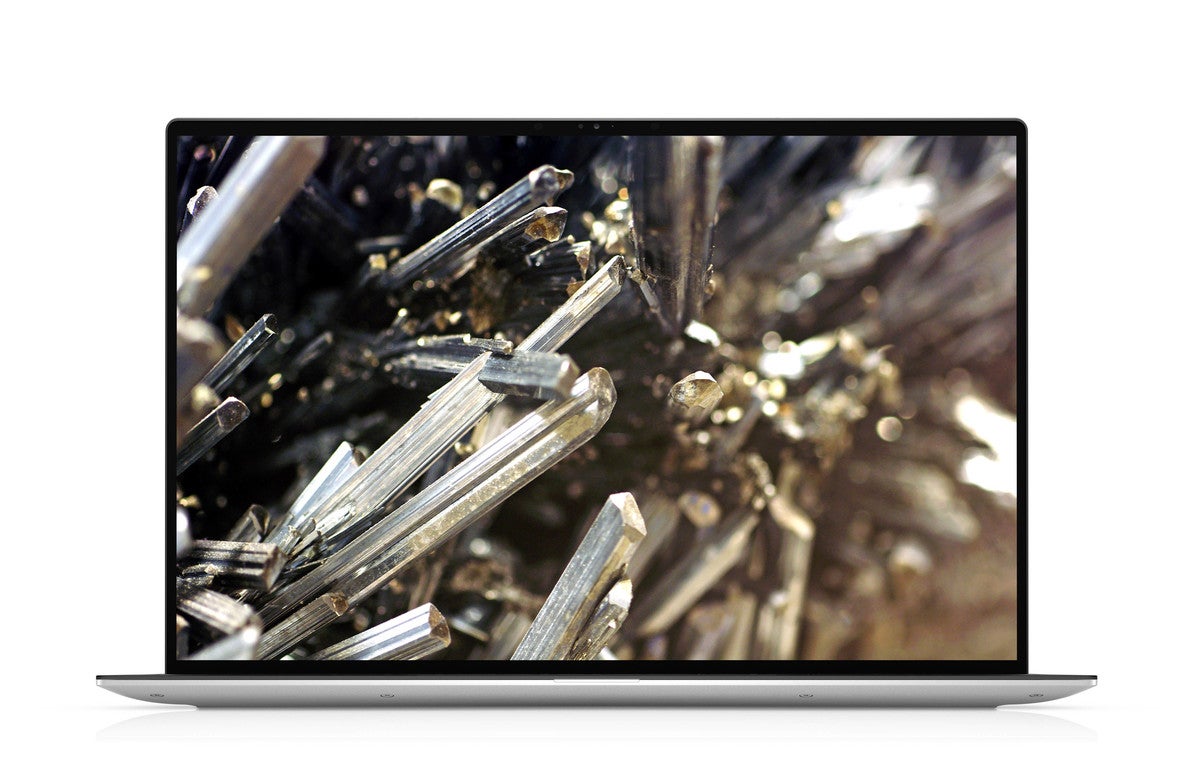 Dell
Dell
Dell’s 2020 XPS 13 9300 achieves full no-bezel.
Why thin bezels matter
Lest you think we’re raving about an inconsequential feature, you just have to look back to 2017, when companies were still selling laptops with so much bezel, you could sell billboard space on them. Apple’s 2017-era MacBook Air, for example, looks about as fashion-correct as disco-era bell-bottom pants and wide-lapel paisley shirts would seem during the grunge era.
 Best Buy
Best Buy
The 2017 MacBook Air 13’s big bezel epitomized the wasted space of laptops of yore, and it looks ridiculously out of date and huge in this day and age.
For the new XPS 13 9300, Dell wisely eschews the common, narrow 16:9 aspect ratio that lowers the overall height of the screen. The company instead goes with a taller 16:10 aspect ratio for the 13.4-inch screen. The top of the screen is about the same height as that of a more conventional 16:9 laptop, such as the HP Elite Dragonfly, giving you more screen real estate without increasing the size of the laptop.
The screen itself is a beautiful 450-nit IPS touchscreen. When we say IPS, we mean actual Sharp IPS too, not the “IPS-like” or “wide-viewing angle” language companies use to describe copycat versions. This is a beautiful, top-quality display that will help you stay productive.
Dell XPS 13 9300 Specs and Features
While the display is clearly the star of the XPS 13 9300’s configuration, it offers plenty more top-shelf parts in its slender chassis. Here are the details.
- CPU: 10th gen Core i7-1065G7
- GPU: Intel integrated Iris Plus
- RAM: 16GB LPDDR4X/3733
- Storage: 512GB Intel 760P NVMe SSD
- Display: 13.4-inch 1920x1200 Sharp IPS
- Biometric Support: Realtek biometric camera in top bezel, Goodix finger print reader integrated into power button.
- Ports: The XPS 13 9300 features one Thunderbolt 3 port on each side, a microSD reader on the left side, and an analog combo audio jack on the right side. Compared to the previous model, you’re losing one USB-C port and the wedge-lock port. As with the prior model there is no USB-A port. If you retain any legacy USB-A devices or just need more connectivity, it’s time to buy a USB-C hub.
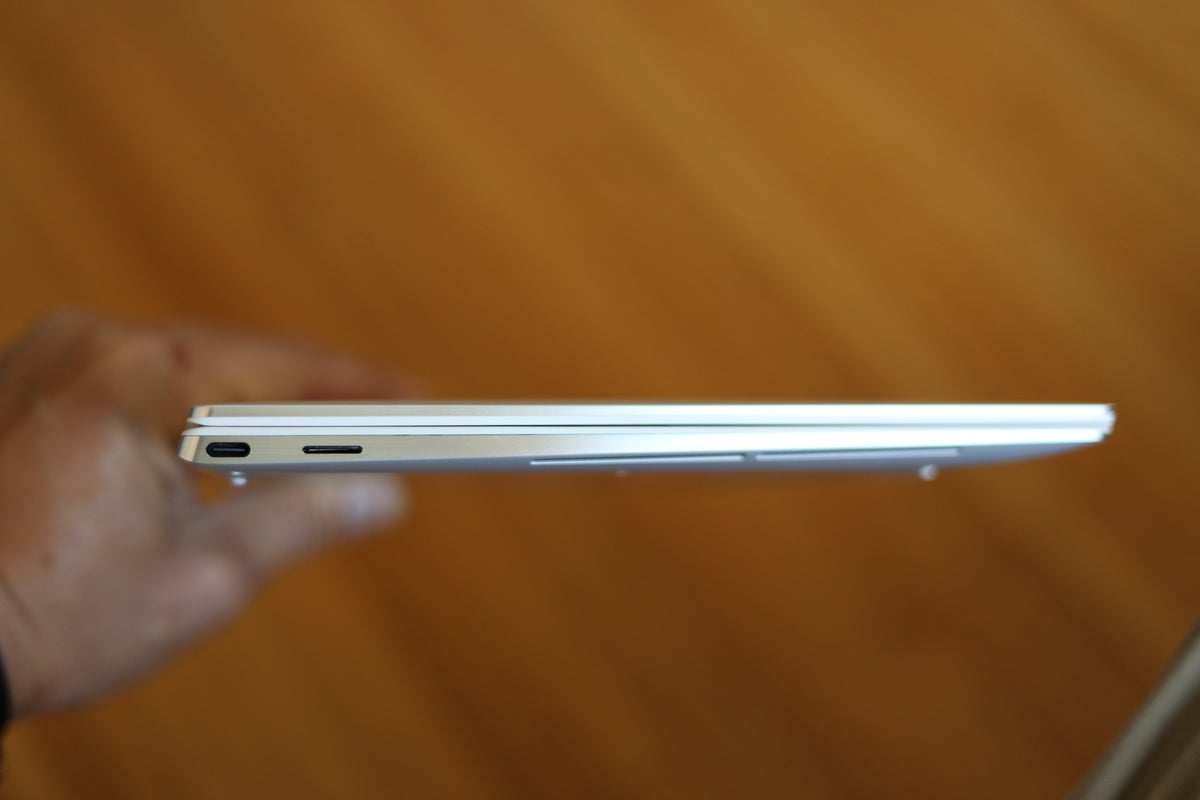 Gordon Mah Ung
Gordon Mah Ung
Ports on the XPS 13 9300 are pretty easy. Each side features a Thunderbolt 3 port. The left side has a microSD reader. The right side adds an analog combo audio jack.
- Networking: Killer Wi-Fi 6 AX1650, Bluetooth 5
- Size and weight: 11.6 x 7.8 x 0.27 inches, 2.9 pounds without AC adapter
- Upgradability: “Upgrades” on modern ultraportable laptops are always very limited, but Dell keeps it down to earth with a standard M.2 slot for the Intel SSD inside of it. This may seem like no big deal, but the XPS 13 2-in-1 7390 soldered its SSD. Dell’s reason (like Apple’s) is to save space and make the laptop thinner, but many have roasted the company for the move.
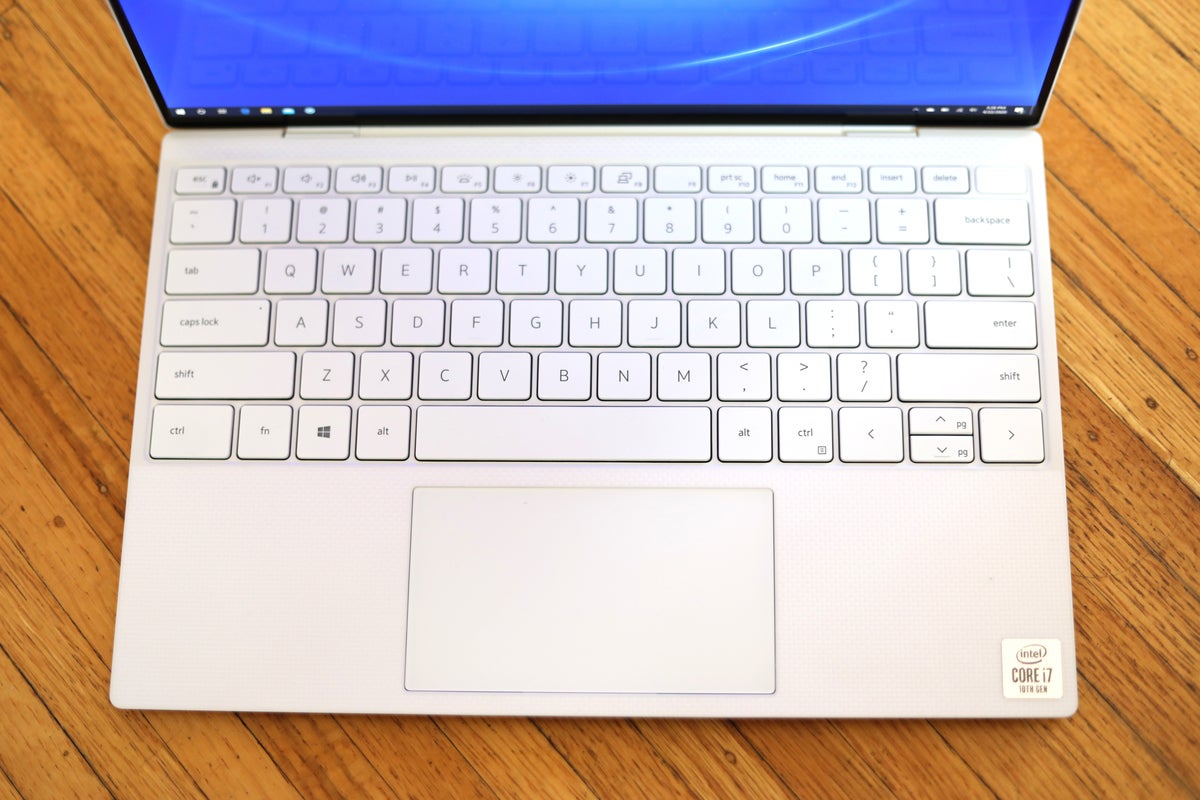 Gordon Mah Ung
Gordon Mah Ung
The keyboard in the XPS 13 9300 is good ol’ traditional dome, and it feels great.
Keyboard, Trackpad and Webcam
One of the better moves Dell takes with the XPS 13 9300 is to stick with a traditional dome keyboard. Although its cousin the XPS 13 2-in-1 is slightly thinner because of its MAGLev 2 low-travel keyboard, it’s a controversial feature. Keyboard feel is subjective, but let’s just say our fingers prefer more travel in our keyboards.
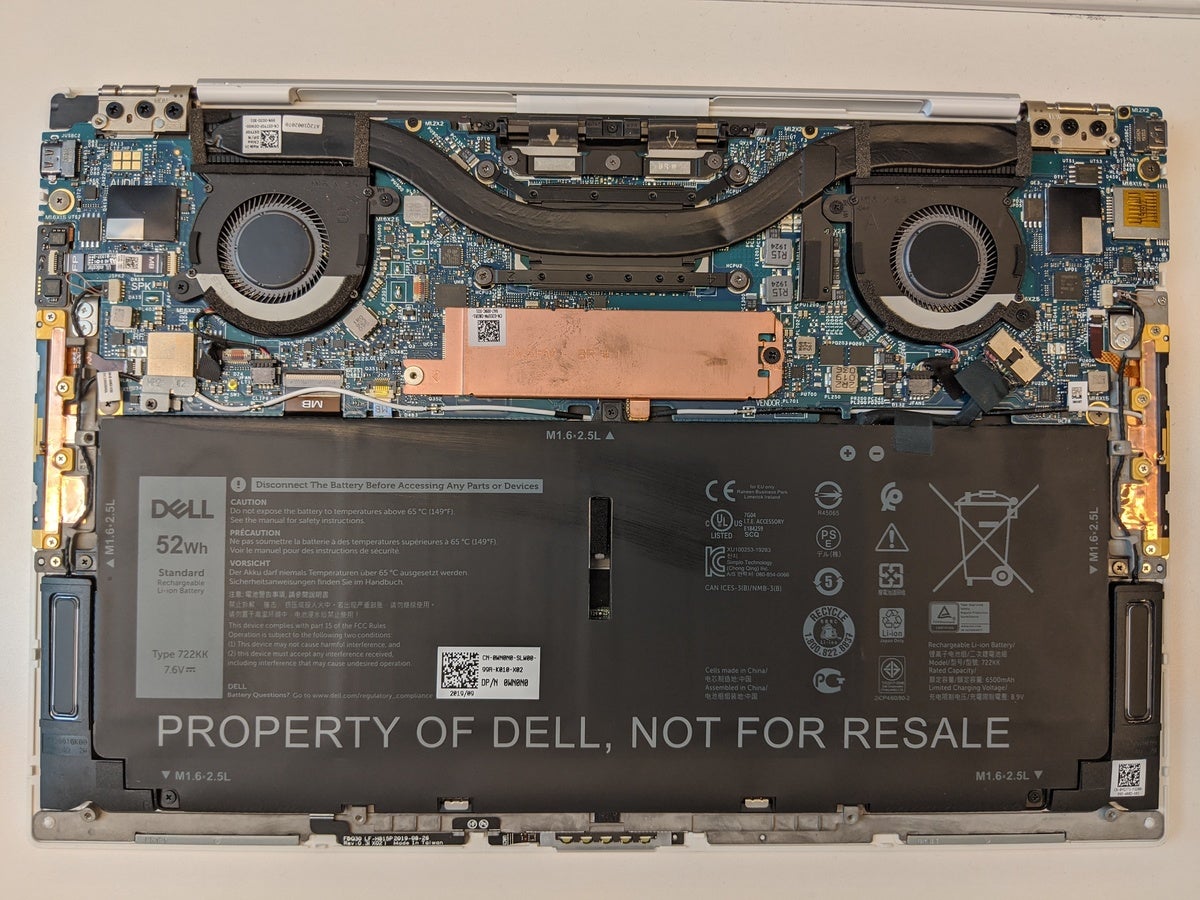 Gordon Mah Ung
Gordon Mah Ung
Dell’s new XPS 13 13 9300 features a single thick heat pipe, two fans plus a standard M.2 slot.
The keys are about 0.75mm wider than the keys from the previous XPS 13 7390’s. They also seem to be a little flatter. Overall, we think it’s an improvement. The trackpad is glass-smooth and support Microsoft’s Precision touchpad drivers. We essentially have no complaints here.
 Gordon Mah Ung
Gordon Mah Ung
The XPS 13 9300’s webcam is fair and far from the worst we’ve seen.
How the world has changed around webcams. Once valued as much for the features that hid them, such as physical shutters and hardware cut-off circuits to maintain privacy, we now clutch webcams to our chests like solid-gold bars.
So yes, webcam performance suddenly matters again. Most models you’ll find use the 720p resolution, but that doesn’t mean they’re all the same. Some vendors, including Dell, may employ software tricks to enhance 720p video quality. Others, including Apple, appear to be caught flat-footed with inferior 720p output. While a 1080p webcam may seems like a desirable upgrade, remember that the higher resolution creates a larger data file—which may end up getting compressed by applications such as Zoom anyway.
We compared the XPS 13 9300’s webcam module to that of six other laptops, including HP’s Elite Dragonfly and the Dell XPS 13 2-in-1 7390. All feature 720p cameras, and all performed adequately. We’d give the Elite Dragonfly Elite a slight edge. Most of the webcams produced overly compressed imagery typical of their tiny sensors and optics. In the end, the XPS 13 9300 produces perfectly fine video for your Zoom videoconferences.
Dell XPS 13 9300 Performance
For the newest XPS 13 9300, Dell takes an interesting approach for the CPU, which is actually somewhat of a step back in performance. You read that right: The performance of the newest XPS 13 9300 is step back compared to the XPS 13 7390, which features a 6-core CPU. We’ll get into how to navigate that later on.
Cinebench multi-thread and single-thread
We’ll kick off the benchmarks with Maxon’s Cinebench R15. It’s a standalone benchmark that measures CPU performance while rendering a 3D image. While it’s not a task many will do on an ultraportable laptop, it’s still a good way to gauge multi-core performance.
The keyword is multi-core, because the quad-core 10th gen Core i7-1065G7 isn’t going to beat the six-core 10th-gen Core i7-10710U that’s used in the XPS 13 7390, even if the latter CPU is a little older. Those concerned about multi-core performance in an XPS 13 may want to nab the older XPS 13 7390 instead of the XPS 13 9300.
 IDG
IDG
In multi-core performance, the XPS 13 9300 takes a step back from the older XPS 13 7390. Both Default and Performance modes are shown here.
Luckily, the most mundane work on ultraportable laptops mostly use just a single core on the CPU. We measure that performance using Cinebench R15 again, set to a single thread. Here, the higher clock speeds of the 10th-gen Core i7-10710U in the XPS 13 7390 still take it higher (coming close to the much heavier, much faster Dell XPS 15 7590), but we’re looking at only a 7-percent gap compared to the XPS 13 9300. Most people would never even feel that.
 IDG
IDG
Single-threaded performance is pretty close between the earlier XPS 13 7390 model and the current XPS 13 9300.
HandBrake
One issue with Cinebench and other similar tests is the short run times. Because modern CPUs rely on boosting clock speeds for short periods, a benchmark that’s too brief doesn’t tell you how a laptop might run on a lengthy all-core load.
To test that, we use the free HandBrake encoder to convert a 30GB movie file using the Android tablet preset. On most quad-cores, you’re looking at 50 minutes of running the CPU hard. Performance of the XPS 13 9300 is in line with that of most 10th-gen Core i7-1065G7 laptops.
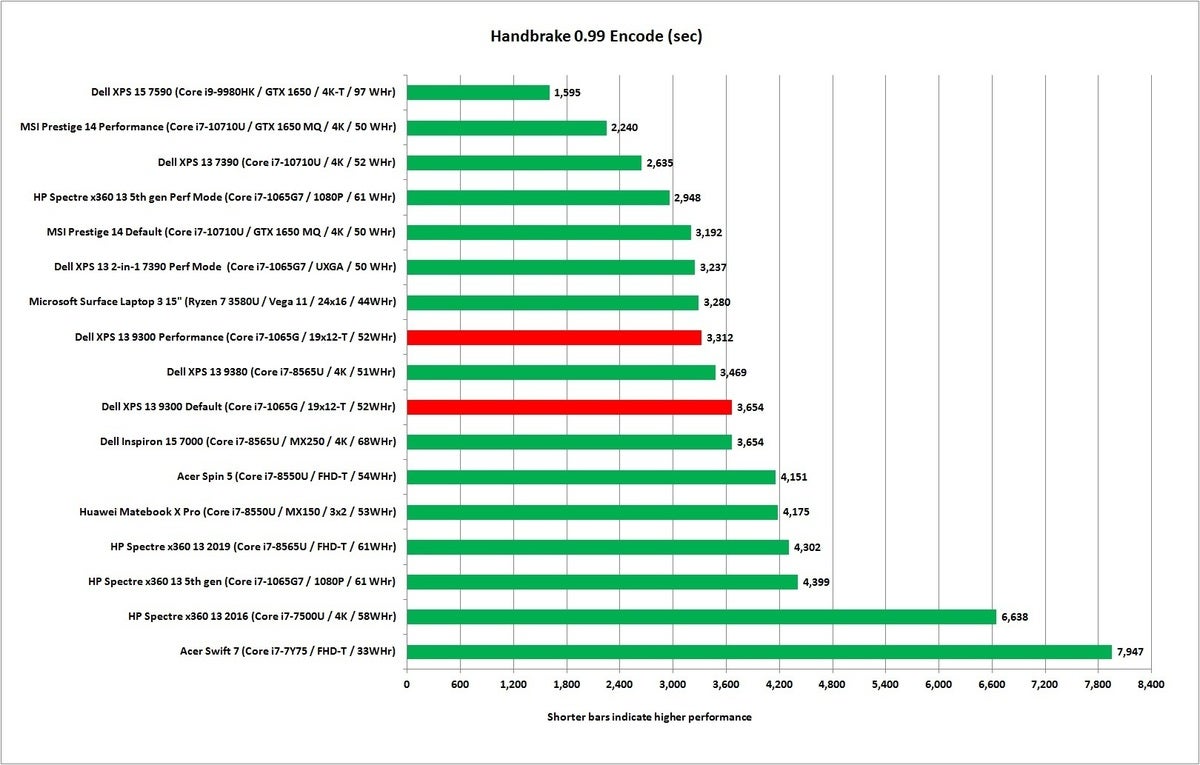 IDG
IDG
HandBrake can take 50 minutes to run on an ultraportable laptop with a quad-core CPU.
As we said before: Unless you really need to hammer an all-core workload all the time, the performance doesn’t matter that much. For example, if all you do is drive Office and a browser all day, multi-core performance doesn’t matter.
PCMark 8 Work
To measure a conventional workload, we use UL’s PCMark 8 Work test. Suddenly the more modern 10th-gen Core i7-1065G7 chips lead the pack, but the margins again are narrow. Remember, if all you do on your laptop is “normal” stuff, don’t get too wrapped up in the performance metric.
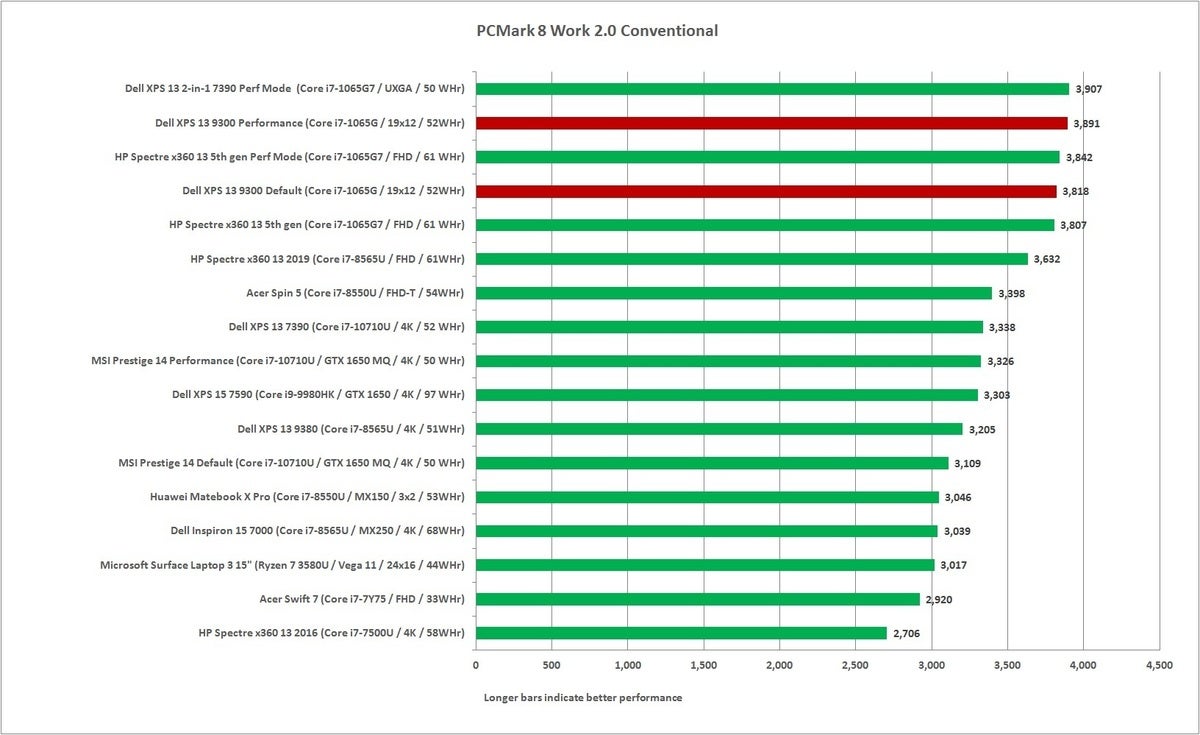 IDG
IDG
PCMark 8 Work tell us the CPU doesn’t really matter much if all you do is drive a browser and Office.
While the 6-core Core i7-10710U in the older XPS 13 7390 leads in CPU tasks, one area where it falls apart is graphics. Here we see the Iris Plus graphics cores in the XPS 13 9300 offer nearly 100-percent better performance than the older XPS 13 7390. That basically mean games as well as OpenCL-based tasks will run faster.
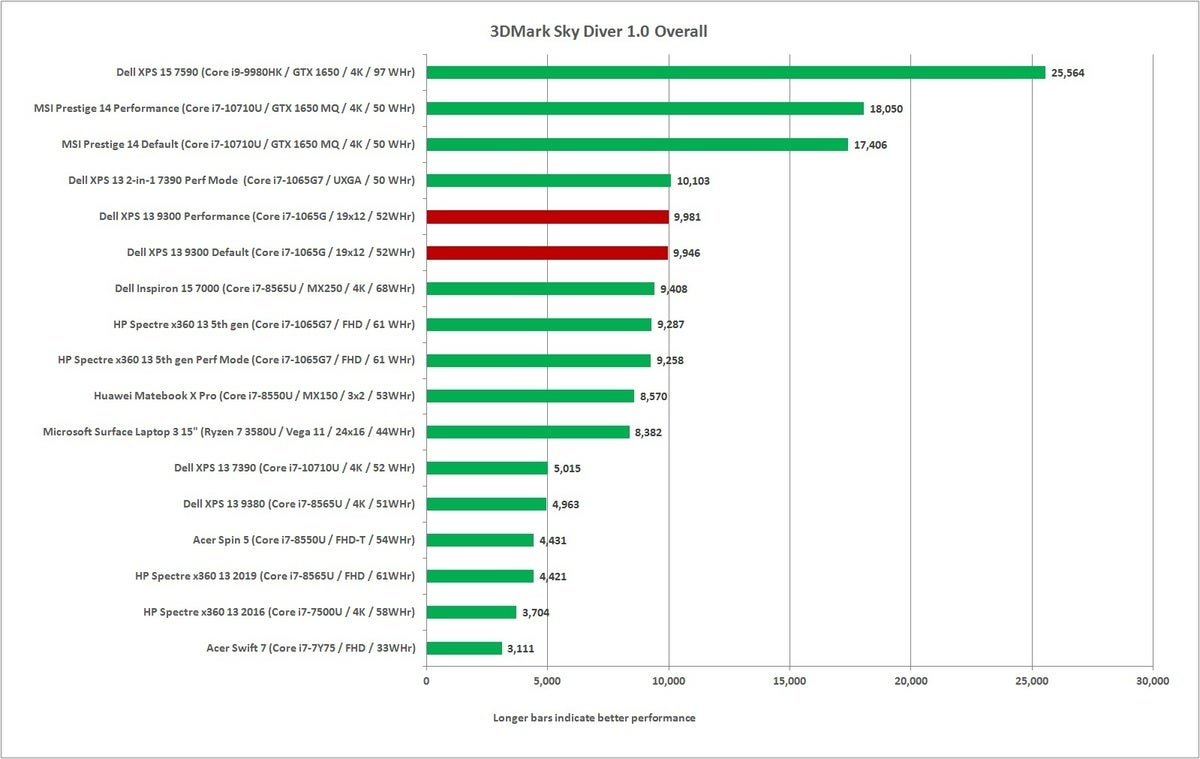 IDG
IDG
The new Iris Plus graphics cores in the XPS 13 9300 easily outrun the older XPS 13 7390’s UHD.
Battery life
The most important metric of any ultraportable laptop is likely its battery life. For our test, we loop a 4K video file using Windows’ Movies & TV app. We set up the laptop as if it were playing a movie on a cross-country flight. We put it into airplane mode and attach earbuds with the volume set to its midpoint. We set the screen brightness to 250 to 260 nits, which is a comfortably bright settting for an office or airplane’s daylight settings.
The overall performance of the XPS 13 9300 is quite good, with playback lasting just over 12 hours. It’s not quite as good as HP’s Spectre x360 13t, which runs to nearly 16 hours, but the Spectre has a larger battery and a “1-watt” panel.
Your mileage will vary. For the light workload of video playback, 12 hours is plenty. We should point out that if you are using Office or a browser, expect to lop off at least a third of that battery life. Push the CPU hard, and expect no more than a couple of hours or so at best. Heavy GPU use might push it under two hours.
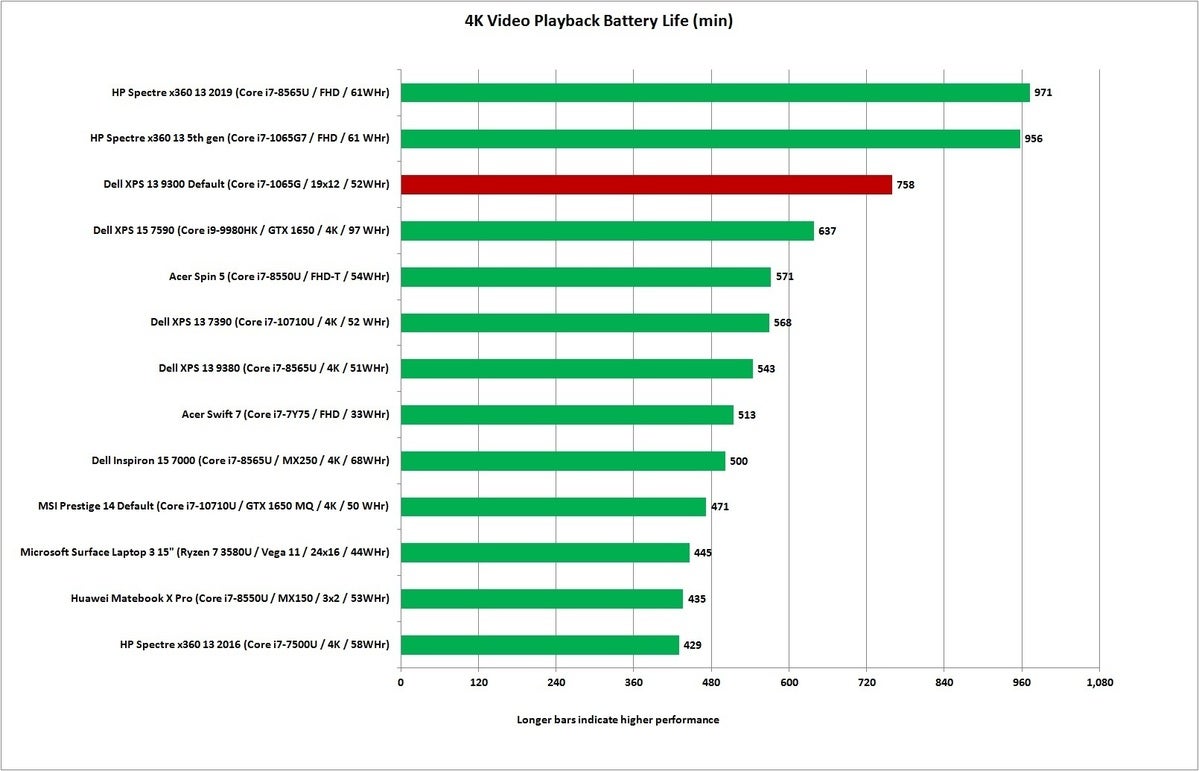 IDG
IDG
The XPS 13 9300’s battery lasts just over 12 hours during video playback.
Conclusion
The Dell XPS 13 9300 enters 2020 with more competition than ever. In 2015, 360-degree designs were still unproven and very rough. Today’s versions, such as the XPS 13 2-in-1, give up nothing while also offering tablet and pen functionality. The utility of those designs are so good these days, we wonder whether the days of pure clamshell laptops are reaching their end.
If we are truly coming to the end of clamshell laptops as the preference, we recognize that Dell’s XPS 13 9300 just might be the pinnacle of what can be done. It’s small, thin, and light, with a beautiful display and nearly flawless features. The addition of Iris Plus graphics erases a weakness with its 2-in-1 cousin. It’s one of the best laptops we’ve ever tested.
Technology - Latest - Google News
April 27, 2020 at 05:45PM
https://ift.tt/2KzUOkh
Dell XPS 13 9300 review: The bezel has finally died! - PCWorld
Technology - Latest - Google News
https://ift.tt/2AaD5dD
Shoes Man Tutorial
Pos News Update
Meme Update
Korean Entertainment News
Japan News Update
Bagikan Berita Ini

















0 Response to "Dell XPS 13 9300 review: The bezel has finally died! - PCWorld"
Post a Comment